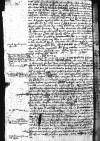List #3299
[Ioannes DANTISCUS] & [part of the Royal Prussia' Council] do Sigismund I Jagiellon[Heilsberg (Lidzbark Warmiński)?], 1547-12-21
Rękopiśmienne podstawy źródłowe:
Pomocnicze podstawy źródłowe:
| ||||||||
Tekst + aparat krytyczny + komentarz Zwykły tekst Tekst + komentarz Tekst + aparat krytyczny
{Serenissime etc.} Serenissime Princeps, Potentissime Rex et Domine, domine clementissime. on the margin⌈Serenissime Princeps, Potentissime Rex et Domine, domine clementissime.Serenissime Princeps, Potentissime Rex et Domine, domine clementissime. on the margin⌉
Humillimam fidelissimorum servitiorum nostrorum in gratiam Serenissimae Maiestatis Vestrae commendationem. on the margin⌈Humillimam fidelissimorum servitiorum nostrorum in gratiam Serenissimae Maiestatis Vestrae commendationem.Humillimam fidelissimorum servitiorum nostrorum in gratiam Serenissimae Maiestatis Vestrae commendationem. on the margin⌉
Cum non parum nos nos,
Quare, cum subiectionis hidden by binding⌈[nis]nis hidden by binding⌉ et fidei nostrae officium hoc a nobis requirat, ut semper Serenissimam Maiestatem Vestram in eo, quo Regnum et Serenissimae Maiestatis Vestrae detrimentum capere posset, cognoscimus on the margin⌈cognoscimuscognoscimus on the margin⌉ praemoneamus illique quod detrimentum Visum itaque Consultum itaque visum est quibusdam superinscribed in place of crossed-out multis⌈multis quibusdam quibusdam superinscribed in place of crossed-out multis⌉ ex dominis
Hoc cum pio debito et officio nostro Serenissimae Maiestati Vestrae ex aliorum quibusdam dominorum consiliariorum suggestione on the margin⌈ex aliorum quibusdam superinscribed⌈quibusdamquibusdam superinscribed⌉ dominorum
Cui nos humillime commendamus eidem on the margin⌈eidemeidem on the margin⌉ prosperrimam ei et longissimam valetudinem cum omnium rerum felicissimo accessu ex animo precantes.
Dat(ae) or Dat(um)⌈Dat(ae)Dat(ae) or Dat(um)⌉ ex aedibus nostris sub unius nostrum sigillo on the margin in place of crossed-out Heilsberg⌈Heilsberg ex aedibus nostris sub unius nostrum sigillo ex aedibus nostris sub unius nostrum sigillo on the margin in place of crossed-out Heilsberg⌉, XXI Decembris MDXLVII.

 AAWO, AB, D. 70, f. 336v
AAWO, AB, D. 70, f. 336v